Around the World in 26 Meals: No. 11 - India (regions: south and east)
Intro
In this post we’re still on India and its surrounding countries, but now we move to the south and the east of India. Having rambled on about how really this series is on South Asia in general in the last post it’s worth noting that in this case the dishes are all from India proper but there are three dishes with some degree of ambiguity. One is a dish common across south India which is attributed as being Tamil in origin - Tamils live in both India and Sri Lanka, there’s no distinctively Sri Lankan ingredients in the recipe but I wouldn’t have expected any to appear given the specifics of the dish. The other two are Bengali dishes but explicitly from West Bengal (a state in India) rather then East Bengal (all of Bangladesh)..
Unlike my last post there’s a chance a lot of this food will be more unfamiliar with British readers - though some, particularly from the east, will be more familiar. Probably the most well known dish from the south of India in the UK would be the Madras (the old name for Chennai, in the south) - although there’s a lot of back and forth between Indians in the UK and in India itself, to the extent that reportedly the most popular cookery website in India is based in the UK, and it’s unclear whether the origins of that curry are in Chennai, the UK or both. In any case, I’m not making a madras in this post - but I am making dosa, the staple you’d find in any dedicated South Indian restaurant but which is quite rare in a typical curryhouse.
And, as a reminder, I’m using the same books as before so please read the last post if you’re interested in my views on those, I make one additional criticism of one of them but otherwise my views haven’t changed much.
What I cooked (and adjustments)
As usual I made the universal substitution of garlic for asofetida and decreased the amount of coriander leaf used in any recipes that featured it. These books so far have been good on including enough spice so I didn’t do my usual doubling of spice quantities.
From the India Cookbook I made the ubiquitous South Indian pancake that I previously mentioned - dosa. I don’t think this is very well known in the UK but it doesn’t seem obscure enough to italicise!
By and large I attempted to follow the recipe faithfully here but as it’s a multi-day process (the batter is fermented) and my kitchen lights had failed I had to plan timings around hours of darkness. Long story short, I ended up accidentally giving it a day’s extra fermentation time. I also decided to add extra water at some points, in hindsight a weakness of the India Cookbook is that it often omits points where it would be useful to add water. On the other hand the recipe called for using a food processor and I did actually figure out how to use it rather than the blender. I’m learnding!
From the same book I also made a sambhar - the lentil-based curry that’s the typical accompaniment to a dosa. This particular recipe is a Tamil version of it and uses vegetable drumsticks/moringa - though it’s worth noting that sambhar is neither exclusively Tamil nor is it particularly strict about what vegetables go in. A similar recipe in the Ultimate Curry Bible uses courgette and recommends adding new, different vegetables after every re-heating for instance and I’d be surprised if my final of my three books doesn’t have a sambhar recipe in it too.
Vegetable drumsticks, also known as moringa. Not to be confused with chicken drumsticks. Image from Wikimedia Commons - user കാക്കര.
This week’s food was very nearly vegetarian but thanks to the following recipe from Complete Indian Regional Cookery - fish in a tamarind-laced coconut milk/meen molee - it’s merely pescatarian. This is a fish dish, often attributed as being Keralan, I think more people know where Kerala is than most Indian states - but if not, it’s coastal and in the south-west. The recipe can use any firm, white fish - tilapia is what was advised and is what I used but only because I couldn’t source monkfish. Also, weirdly, the recipe doesn’t actually contain any tamarind - I assume the editor just had a slip up there. It happens.
No intentional adjustments were made except that, because I could only find frozen tilapia, I had a bit of liquid left after it thawed which I added into the sauce. As this added some volume I did remove the fish before the end of cooking to give the sauce a little more time to thicken.
I also made a side-dish, spiced potato cakes/alur bora, which were apparently a dish from colonial times in West Bengal which retained its popularity upon independence. I didn’t really adjust this recipe.
Roasted tomato chutney was recommended to go with the alur bora so I also made that. This is another West Bengal recipe, specifically from Darjeeling - the same Darjeeling you’re thinking of, up in the mountains where the grow the famous tea. As a tangent, contrary to popular belief tea is actually best grown in quite a cool climate and the reason why it’s grown in the mountains is to protect it from tropical heat. Tea plants actually grow fine in Western Europe so presumably these mountain plantations were initially favoured due to economics rather than botany (tea being a labour-intensive plant to harvest)!
Darjeeling is actually very close to Sikkim (the state of India directly between Nepal and Bhutan and south of Tibet) so, arguably, this would actually have been a better fit for the next post than this one. Ah well.
In any case, I was a bit lazy with this and, as the all ingredients were blended together at the end, decided to not bother chopping the chillies, ginger and coriander leaf that went in.
I only cooked one recipe from the Ultimate Curry Bible, for this post. This was a cucumber, mint and tomato raita and can’t recall any adjustments I made to it. Raita actually isn’t particularly south Indian but apparently it’s a bit more popular in the south so let’s use that as a justification for this recipe being in this post!
Finally I did some plain boiled basmati rice. I’m a big boy now so was able to figure that one out by myself. Volumetric cooking rather than draining any excess water, as, again, either are acceptable in Indian food.
Cooking
The dosa was the only dish that needed multiple days of preparation (simplified versions of it exist that require less prep work). This started with soaking of basmati rice, parboiled rice (variety unspecified, I used more basmati) and lentils (urad dal) for several hours on day 1.
These were drained and put in a food processor with some fenugreek seeds. The processed rice and lentils were combined together and left to ferment - dosa is fermented both by yeast and lactobacillus (ie both the fermentation used for bread and beer and the fermentation used for yoghurt) and I left it to do its thing overnight.
On day 2 I realised this texture of paste clearly wouldn’t function as a batter so I added more water and gave it some more fermentation time. By day 3, when all the rest of the cooking was to start, it was very bubbly!
Said bubbliness made thin, crispy dosa (the kind more commonly found in restaurants in the UK) a challenging proposition, the mix simply didn’t flow easily, so I decided to go for a softer variety. With one side uncooked and with the bubbles it almost looked like injera bread at some points (though the picture doesn’t really capture this)! For fans of Ethiopian food I have exciting news - I don’t have any cookbooks from that cuisine so I won’t be cooking injera bread even though I have found a source of the necessary flour (teff). By exciting I meant disappointing, sorry.
Yes, the hob’s not as clean as I’d like.
And ultimately I’d made passable dosa - limited primarily by my actually being very bad at flipping pancakes. I’ve the same problem with English pancakes and crêpes.
I must admit I had trouble judging how good my dosas were - I’ve never actually eaten a soft dosa before. I found it far more distinctive than the crispy ones and more suitable as a substitute for rice as well. And, counterintuitively, these softer dosas were a lot more different to an “ordinary” pancake than the crispy ones, the flavour is just far more obviously drastically different.
I enjoyed them but I think it’s clear there’s a lot of nuance in the making of dosa and a lot more to learn beyond what the recipe itself could teach. My poor pancake-flipping skills aside I think I made some acceptable dosa but I know I could potentially do much better in future!
After making my dosa I travelled back in time and started on the sambhar. You can tell I travelled back in time because I uncooked and unmixed my dosa.
I chopped all the veg and made a simply spice mix for later on in the cooking. I also soaked the toor dal lentils seen in shot later on as they only needed half an hour.
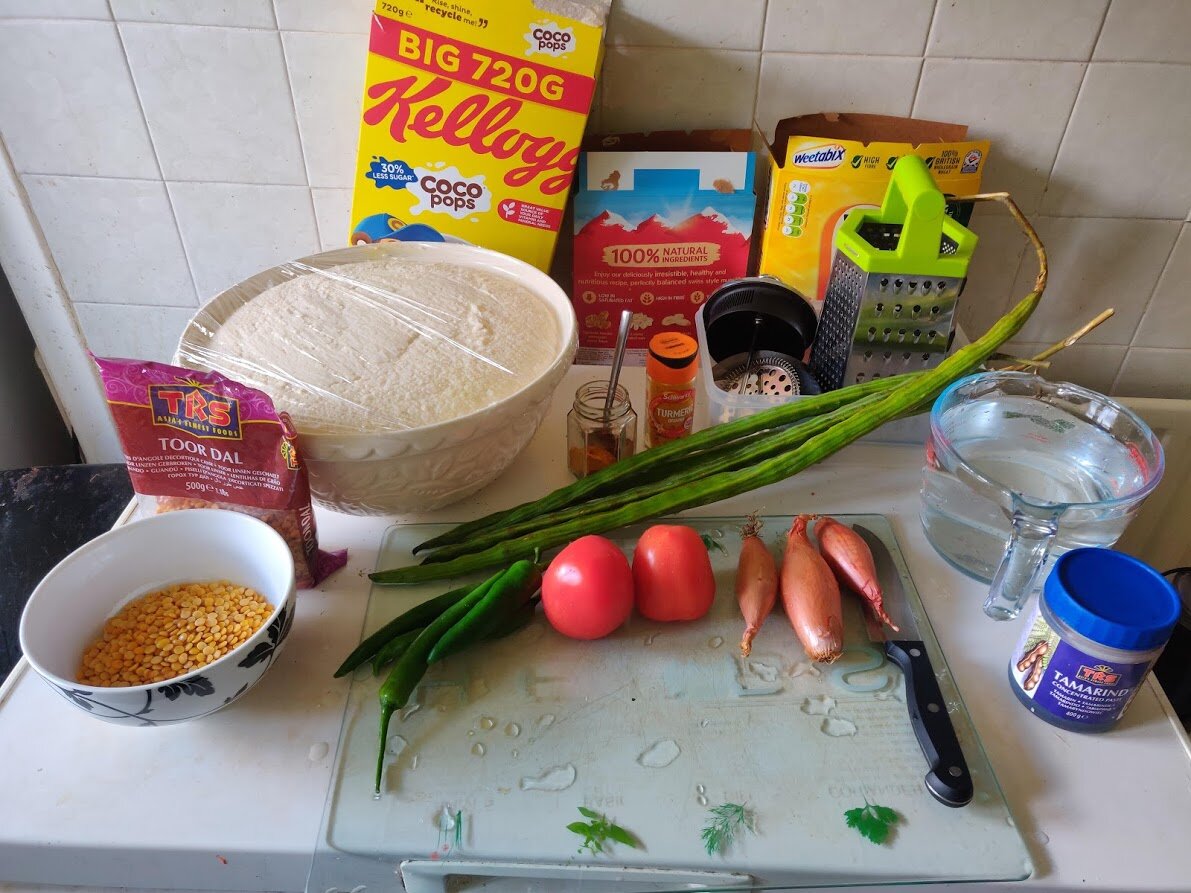
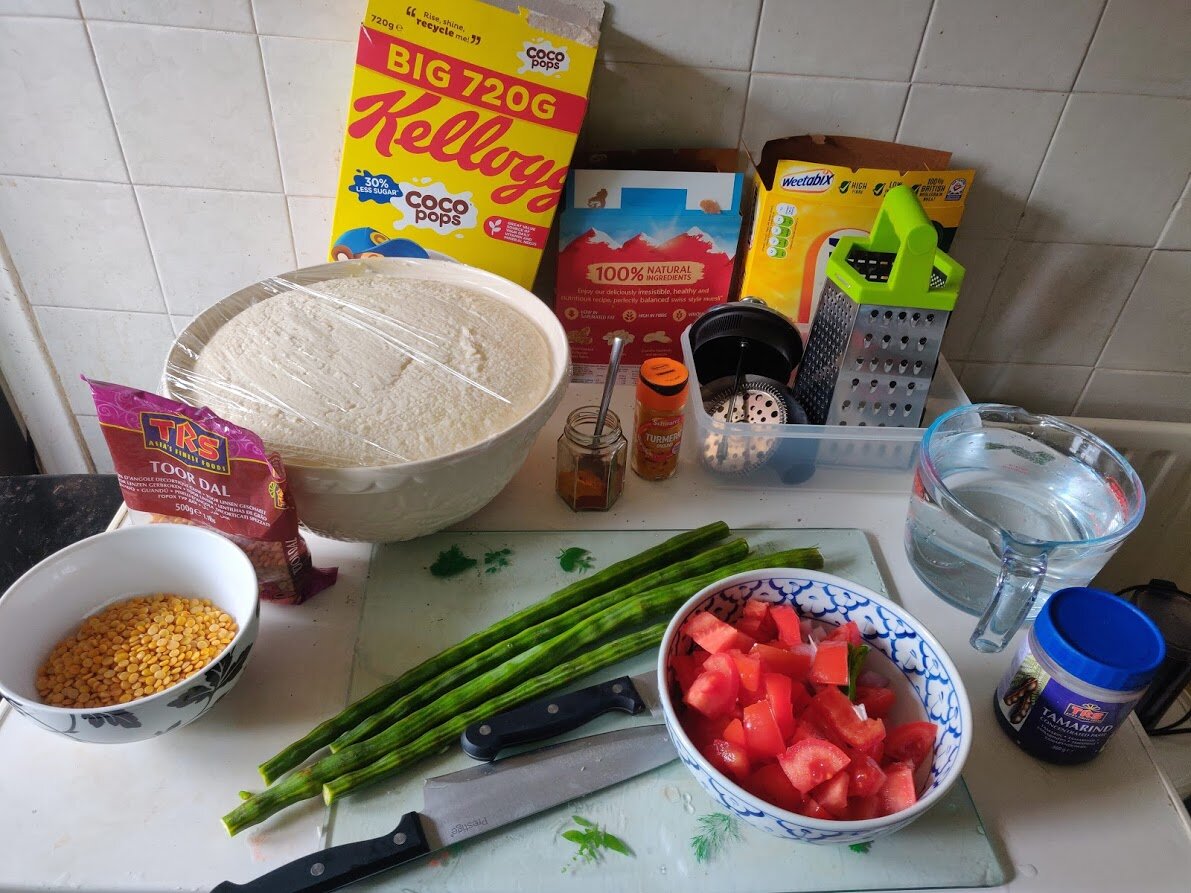
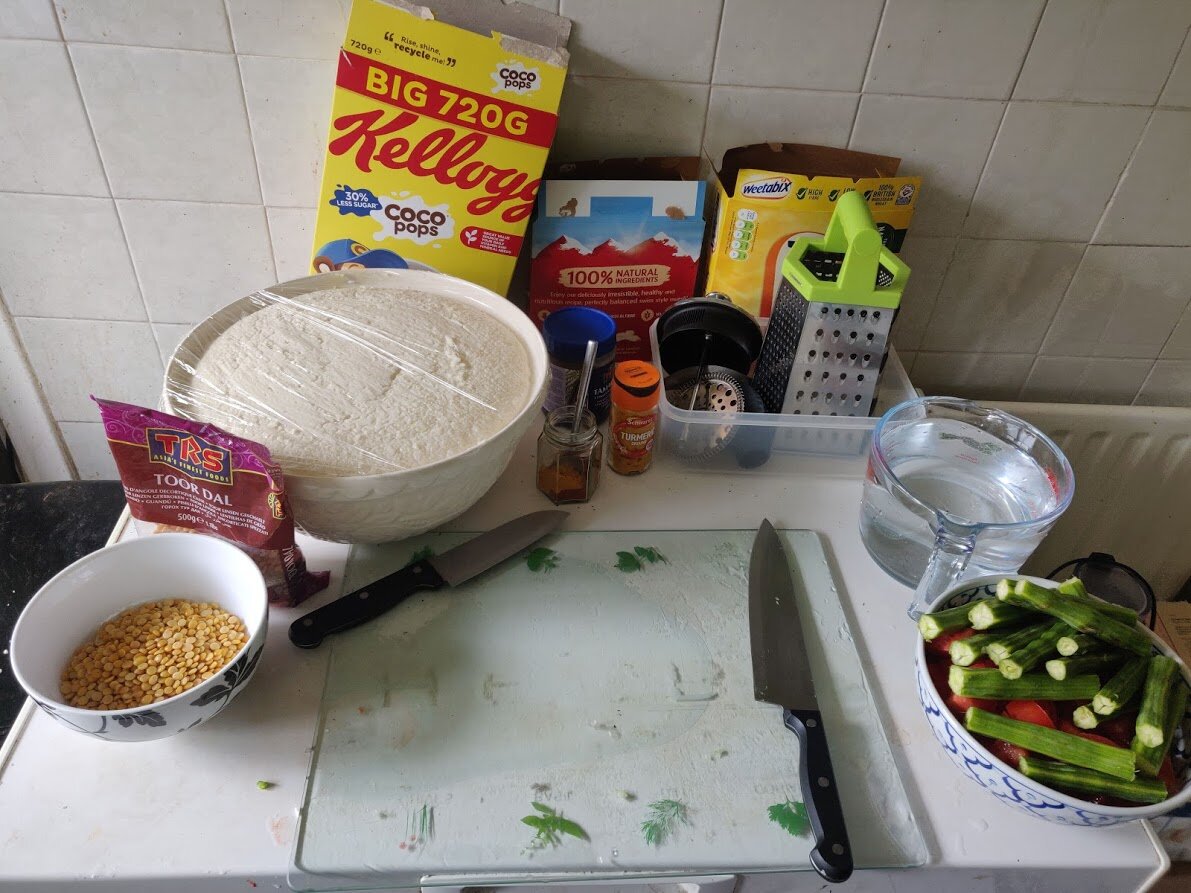
Afterwards I also prepped some leaves (curry and coriander) and a spice mix for tempering later on - this is where spices are briefly fried and then added to a dish near the end of cooking. I’m unsure how common it is outside Indian cuisine.
Sambhar also has its own masala mix so I got to work on that - roasting coriander seeds and mixing together the ingredients shown (including the leaf, the lentil mix and also the mustard seeds from the jar with the unreadable label in the background). These had to be blitzed in a coffee grinder and produced about 400ml of spice mix.
I only actually needed a couple of teaspoons so I guess I can skip this step if and when I make this again. And again. And again.

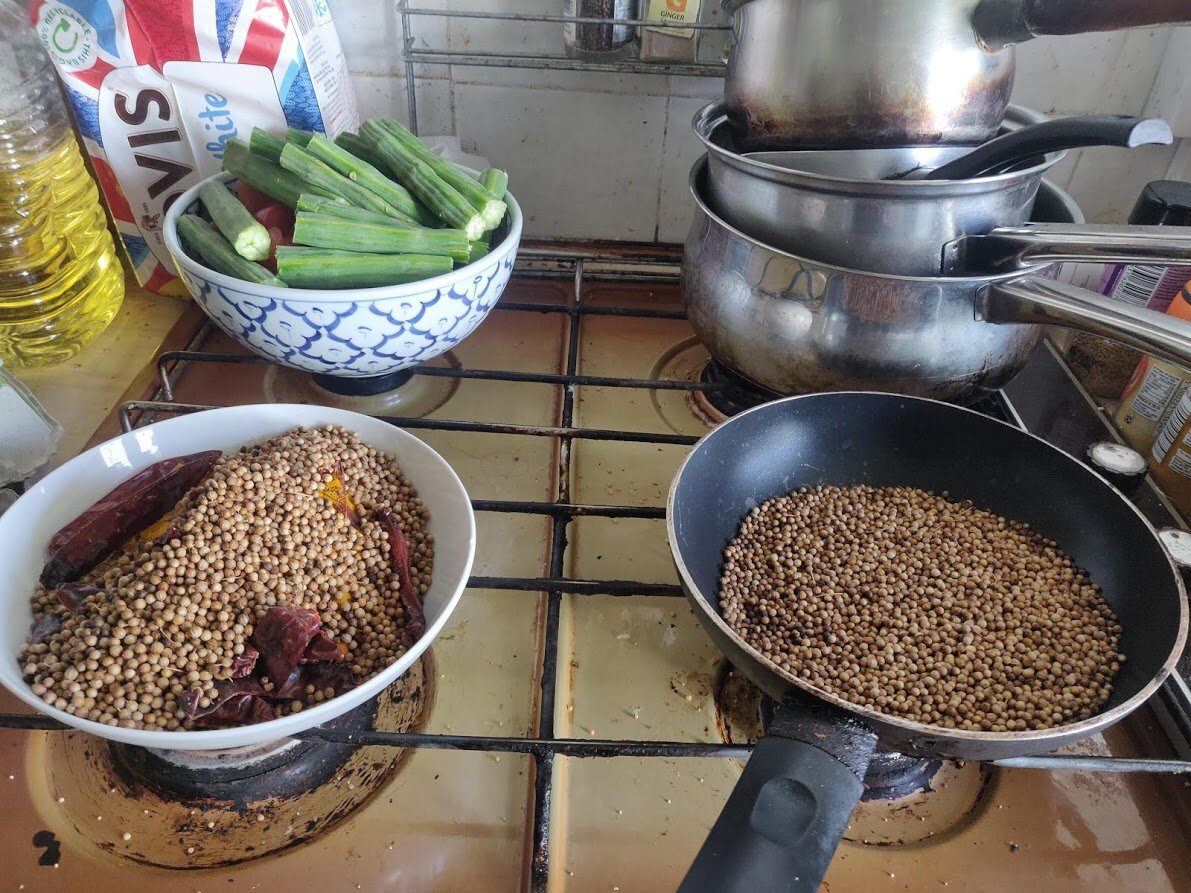
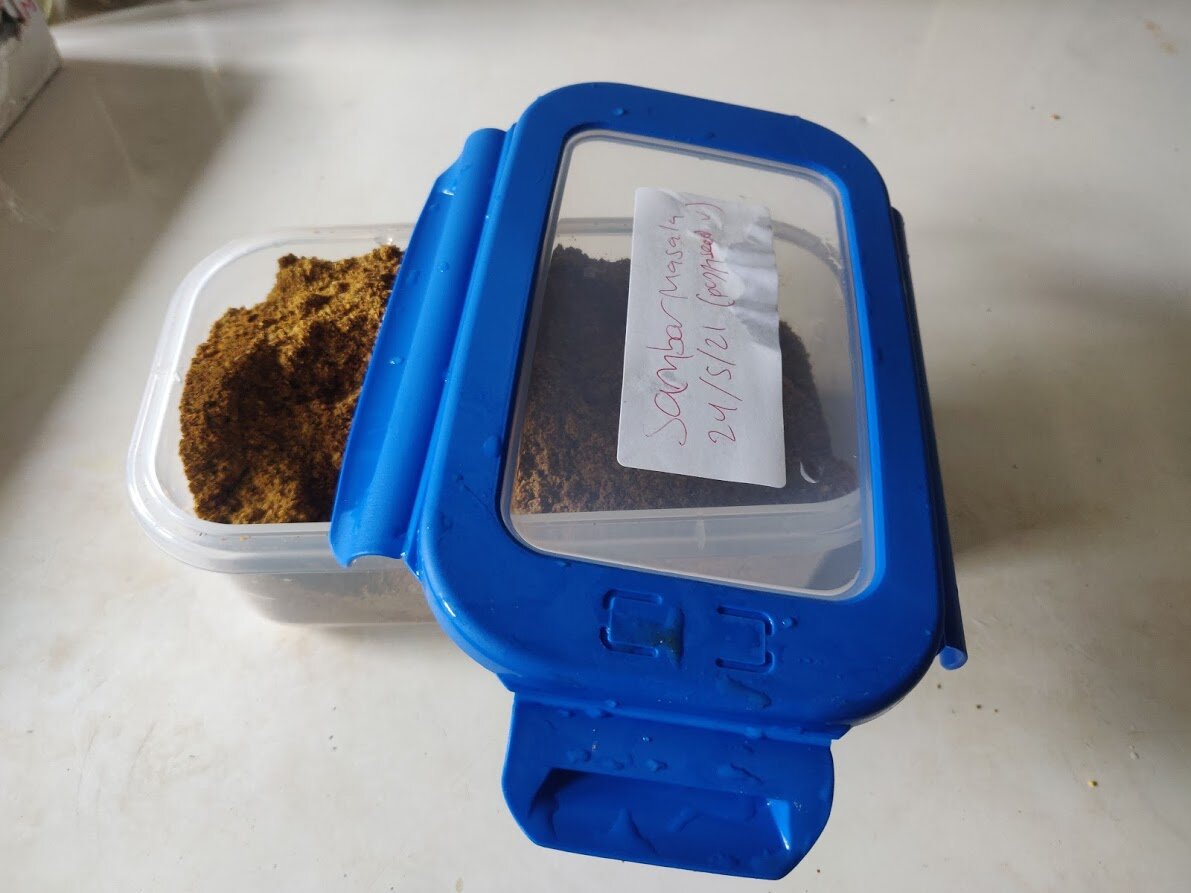
In the meanwhile I’d been forgetting to take pictures of me cooking the ingredients from the first photo - essentially I just boiled all those ingredients together for 20 minutes then added my masala. I then tempered my remaining spice mix and added the curry leaves (also tamarind extract - not pictured), combined everything and took a blurry photo that was somehow the least worst one I had of the finished dish.
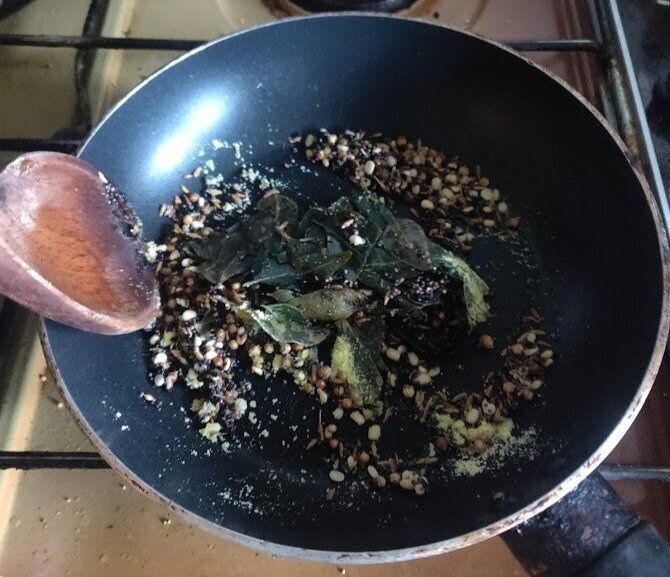
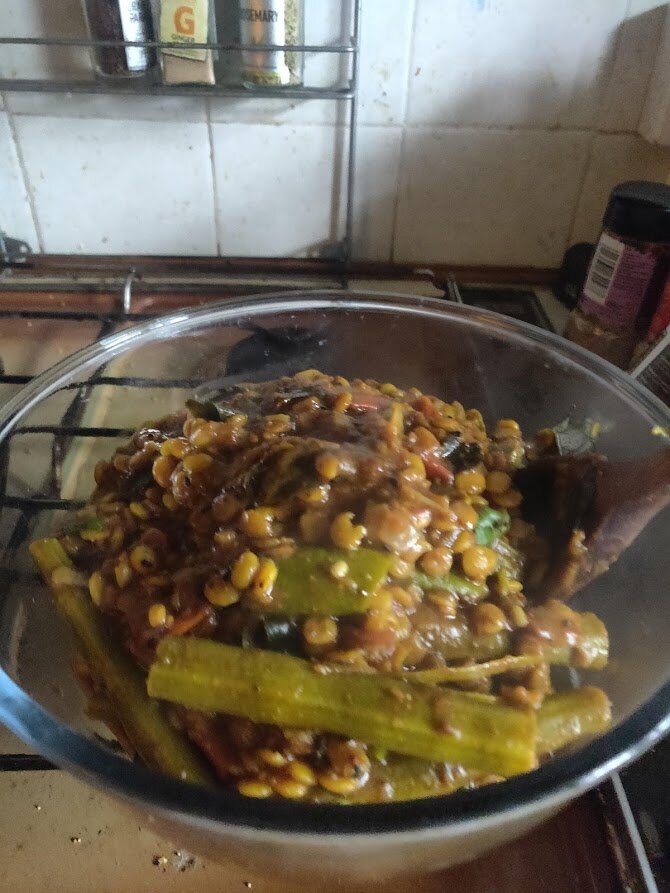
Despite not getting a good photo if it I was a fan of the sambhar. I often find that purely vegetarian dishes can be delicious but still leave me still hungry afterwards unless I eat quite absurd volumes - evidently my body needs quite a lot of protein to feel satiated.
No such problems here, not a low bar to pass for a vegetarian dish. There certainly were things that I could criticise, it did end up a little bit too hot to eat a lot of in one sitting and it turns out vegetable drumsticks are actually a pain to eat - they have a nice taste but the rind is inedible and very fibrous so actually eating one involved a lot of cutting and scraping! Nevertheless, I’m a fan of this - the flavour profile is lovely even with the heat being a smidge above my preference and I could always make my next sambhar with a different vegetable. Also it’s usually quite soupy in texture so I’d try harder to get it like that, rather than worrying about timings.
As is typical I was making a lot of these things in parallel, so I’m now going to zip back to show my making the roasted tomato chutney. In a shock twist the first step is roasting some tomatoes - so here’s a picture of them covered in oil.
Here’s another picture of tomatoes - with my rice, the part-done sambhar (I had a photo after all - the ideal consistency would have been somewhere between that and the final product) and some onions I was frying for the meen molee also in shot.
I actually forgot to take a photo of the final chutney (though it will appear in some of the combination shots at the end of this section) - I found its flavour delightful but I also am pretty sure I over-blended it and ended up with it being too watery.
The colour was also a dull orange rather than a vibrant red, which is a shame, but possibly caused by the presence of asfoetida - and removing that would negatively impact the flavour. So perhaps the lesser of two evils.
Another relatively quick and simple recipe was my raita - I’d already roasted some cumin (on the plastic plate) and otherwise this was a simple matter of chopping some veg and mixing everything together.
I was a little short on bowls at this point in cooking though so the raita ended up in a rather odd container! This very shallow glass bowl is perhaps not the best vessel for it.
However overall I was a fan of this - it was simple with a nice balance of flavours. The two faults I could attribute to it were that it was best consumed fresh - the cucumber got soft and unpleasant when stored for a couple of days - and that it was a little less thick than I’d like, probably because of the new water introduced from the vegetables.
Beyond the dosa and sambhar I had one more dish intended as a main course - the meen molee, I hope the peek behind the curtain earlier, seeing that it involved frying onions, didn’t ruin the surprise of how it’s made. So few recipes involve frying onions after all.
I didn’t photograph the first step, which was simply cutting the fish into chunks and rubbing it in lemon juice and salt. After that I fried some onions and added ginger purée, asfoetida and chillies.
Hey, there’s the roasted tomatoes again!
Some chilli powder and turmeric was added.
Followed by some creamed coconut, which very slowly melted into the sauce. Salt and lemon juice was also added to the sauce at this point as well as the liquid from the thawed fish. And I roasted some coconut flakes for a garnish.
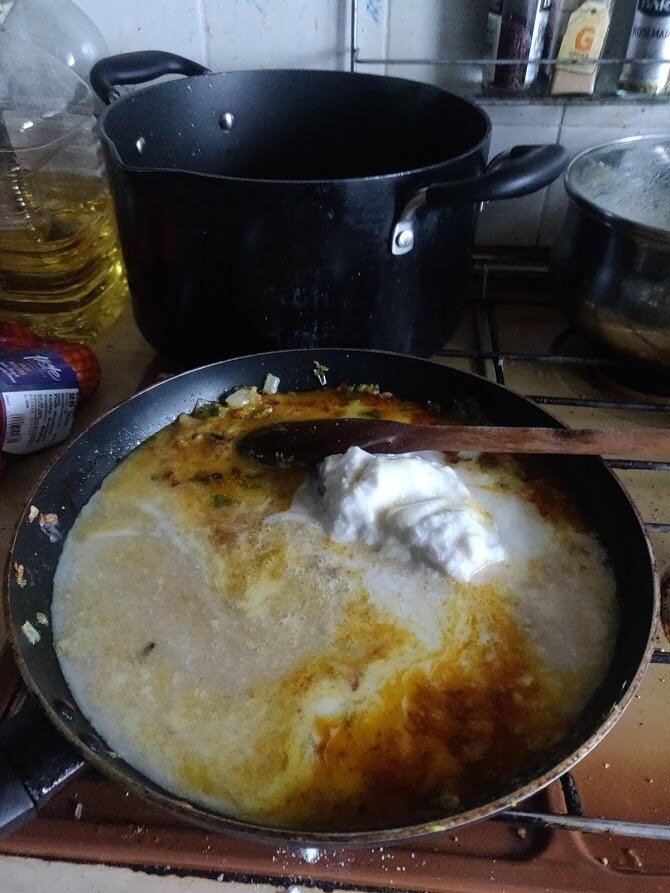
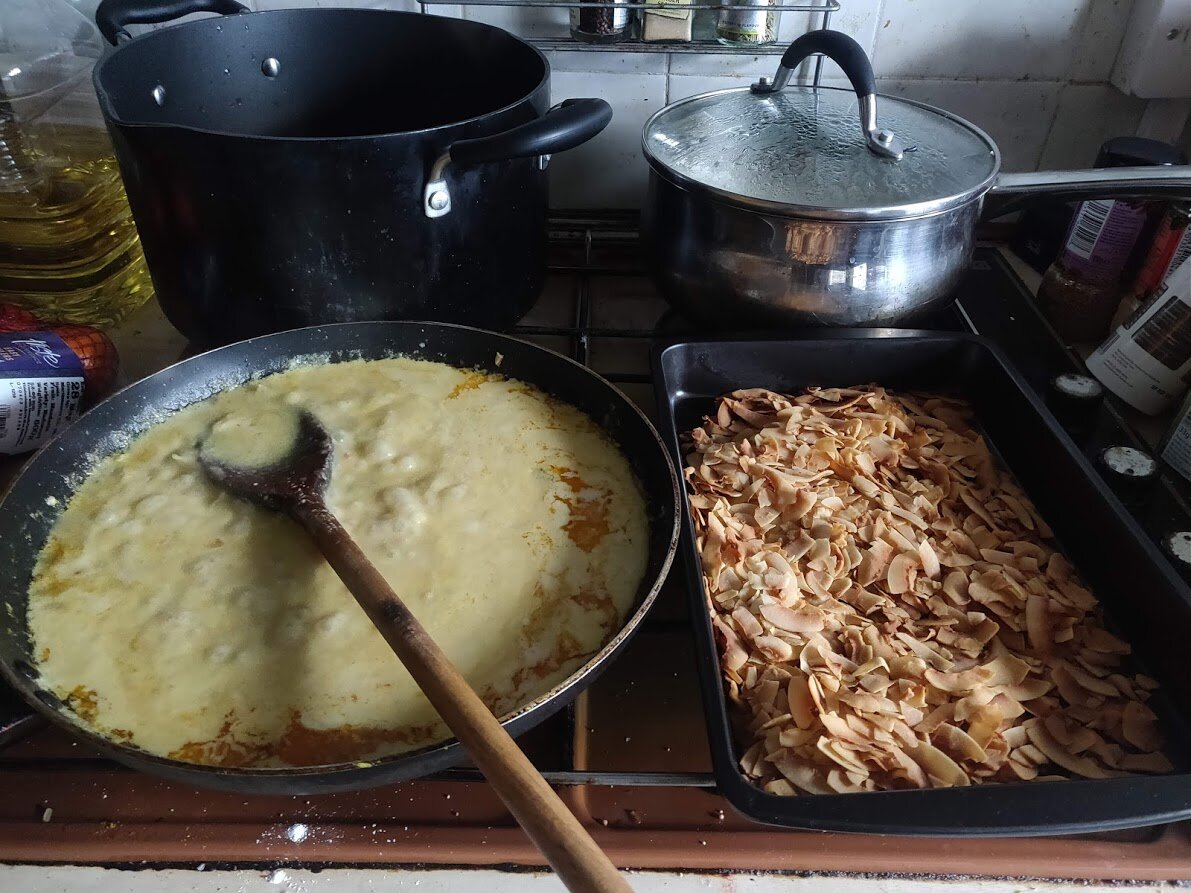
Then the fish was added and cooked for a short time.
Deviating from the recipe I remove the fish and thicken the sauce a little more. These are later recombined but I actually prefer the photo of them separate. So I’ll end there.
Overall this was a very plesant, mild fish curry. I could, unfortunately, notice that the fish had been frozen which did detract somewhat but this same recipe with fresh fish would be something special, I think.
The final recipe to cook was the alur bora, the spiced potatoes. In reality I made the mix quite early, before the sambhar, but I finished off this recipe near the end of the cooking session, second to last behind frying the dosa
As is standard some vegetables needed chopped.
This was followed by boiling the potatoes and frying some fennel seeds.
Sequentially onions, chillies, ginger paste and coriander leaf were added to the fennel.
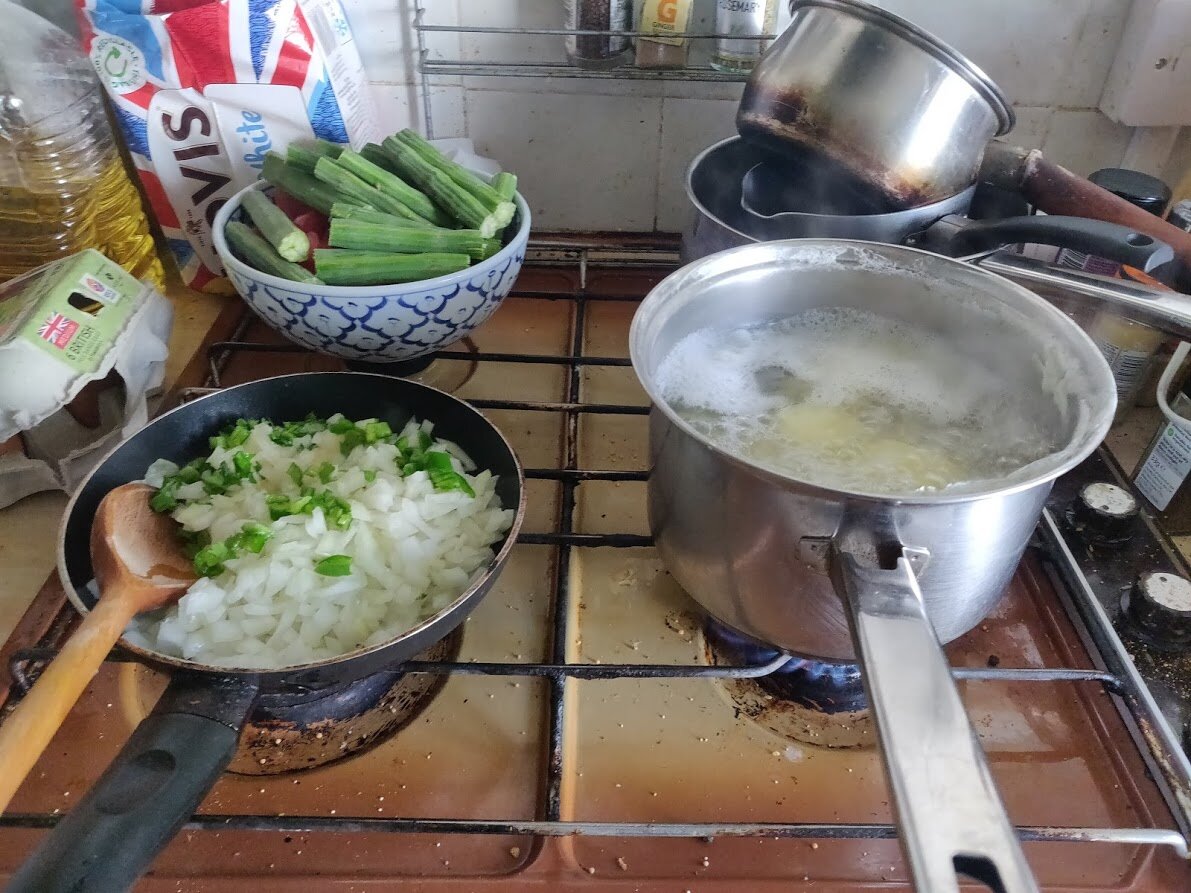
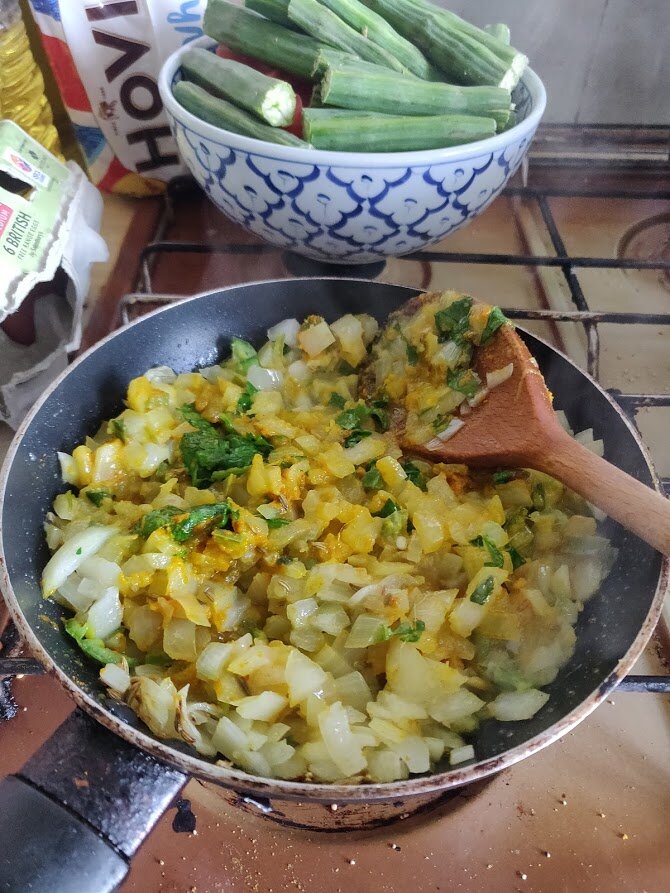
I mashed the potato in butter then added this fried mix, along with egg and cornflour in order to make some disgusting looking slop.
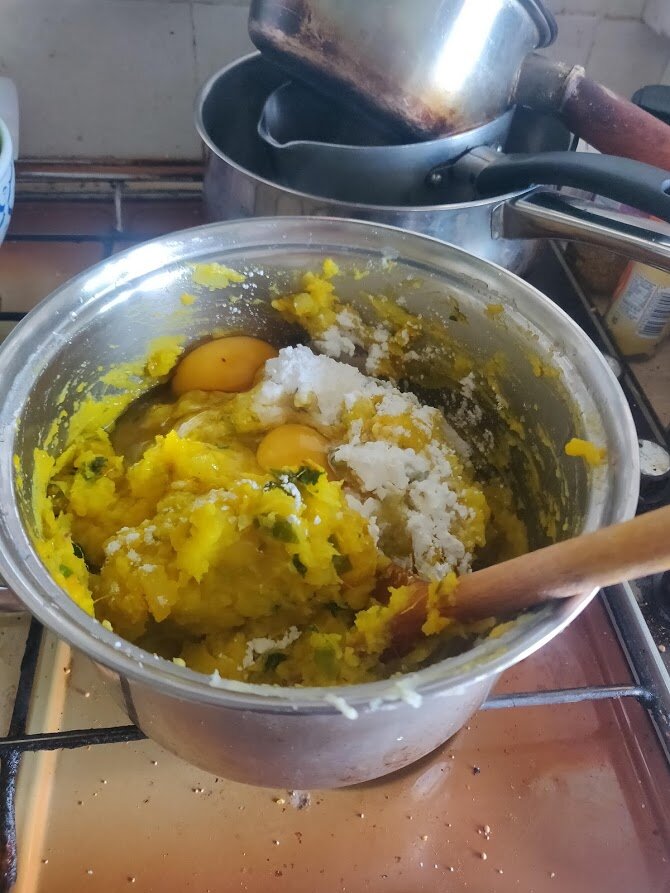
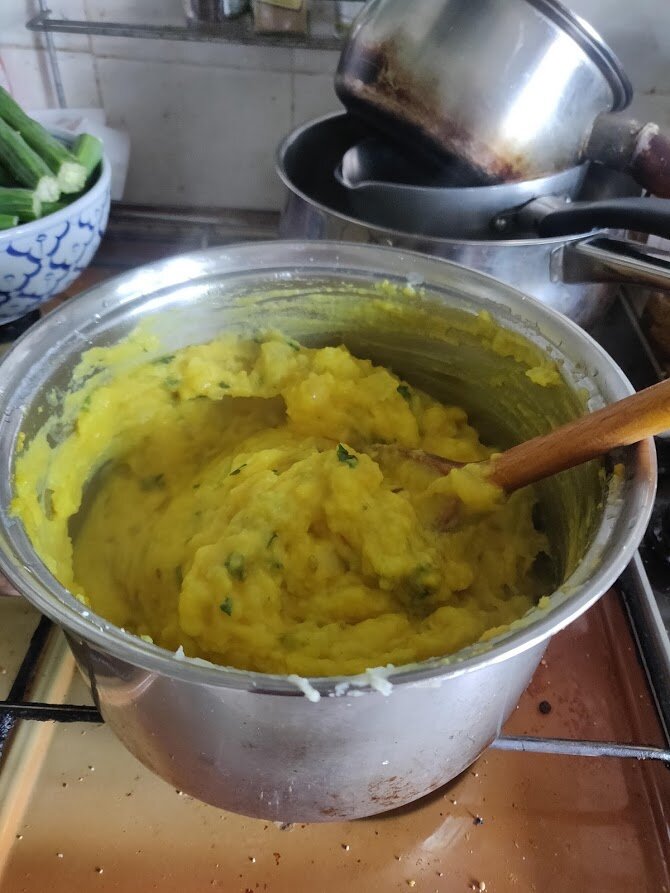
Said slop is then fried (in quite a depth of oil) and drained. As always it’s quite difficult to fry these without them falling apart but, all credit to the recipe, this is actually probably the least trouble I’ve had with a recipe like this. The potato cakes are more robust than they look while cooking.
The final result looks overdone.
However it only looks burned, not a hint of burnt taste. In fact it’s delicious, with a delicate flavour and a deceptive lightness. These were probably the biggest surprise of the whole project as I had quite low hopes for them during their cooking. Potato fritters have cropped up quite a lot in this series of posts and this has probably been my favourite variant on a potato fritter that I’ve ever cooked.
Although I don’t think my enthusiasm for this food has really shone through in my writing for this post I was actually very happy with all of this and, if anything, the alur bora was the dish I was most pleased with overall. I took a final photo of some of the food, sadly without these potatoes, and, despite it all looking a bit brown it was a very tasty meal indeed!
The dog tray is traditional in India but has to have the dogs upside down in the south.
What I’d do differently
Overall I was reasonably happy with these dishes - certainly there’s some subtlety to making dosa so I would be likely to try and supplement my knowledge with other recipes and try and get more of a feel for it if I decide to make it again. My gut instinct is that I should have watered down the batter a bit more and maybe given it a bit less fermentation time if I wanted a thinner pancake.
With the sambhar I’d probably swap out the vegetable drumsticks for something easier to eat - the flavour was fine but it was inconvenient to eat and with such a flexible dish I don’t really feel bound to a vegetable I’m pretty lukewarm on. I’d probably also reduce the volume a bit less, as said earlier it does look more like a thick soup done properly.
Naturally with the chutney I’d blend it less. I’d probably also cut up the non-tomato ingredients ahead of time rather than just blending them so it’d be easier to get a chunky texture without insufficiently distributing the ginger.
Otherwise I’d probably only make fairly small changes - obviously meen molee would probably be better with fresh fish, alur bora would be a bit easier to handle with more cornflour or a bit prettier with less heat in the oil and the raita may be a bit thicker if I dried my veg after chopping, but despite everything in this post being noticeably imperfect I’m broadly happy with it all. Hopefully it could become less imperfect with practice.




















